Looking back at the Khakhovka Dam explosion one year later (Photos)
Support independent journalism in Ukraine. Join us in this fight.
Become a member Support us just onceKHERSON OBLAST - When Russian forces blew up the Kakhovka Dam on June 6, 2023, they changed the landscape of southern Ukraine permanently. The breach unleashed nearly 20 cubic kilometers of water from the Kakhovka reservoir, a massive body of freshwater spanning three oblasts. Water levels in several cities in Kherson Oblast rose to 11 meters within hours of the breach, drowning 80 settlements across Ukraine's south and killing hundreds.
The dam's destruction has resulted in a humanitarian catastrophe in Zaporizhzhia, Dnipropetrovsk, Kherson, and Mykolaiv Oblasts. Around 600 kilometers of land was flooded, devastating the rich farmland in the region and threatening long-term economic development. With 90% of the reservoir drained, 700,000 residents in Ukraine's warmest oblasts suffered water shortages in the peak of last summer.
The Ukrainian government went to work in July 2023 to build a 145-kilometer water pipeline to supply 1.5 million people. Kherson Oblast was impacted the most with 37,000 houses damaged. The Russian-occupied left bank suffered heavily, housing 68% of the flooded settlements.
Some residents on the left bank were stranded for days waiting for help. On the Ukrainian-controlled side, rescuers evacuated thousands even under heavy shelling from Russian forces.
 People being evacuated from flooded areas after the explosion at the Kakhovka hydropower plant unleashed floodwaters in Kherson, Ukraine on June 7, 2023. (Muhammed Enes Yildirim/Anadolu Agency via Getty Images)
People being evacuated from flooded areas after the explosion at the Kakhovka hydropower plant unleashed floodwaters in Kherson, Ukraine on June 7, 2023. (Muhammed Enes Yildirim/Anadolu Agency via Getty Images)
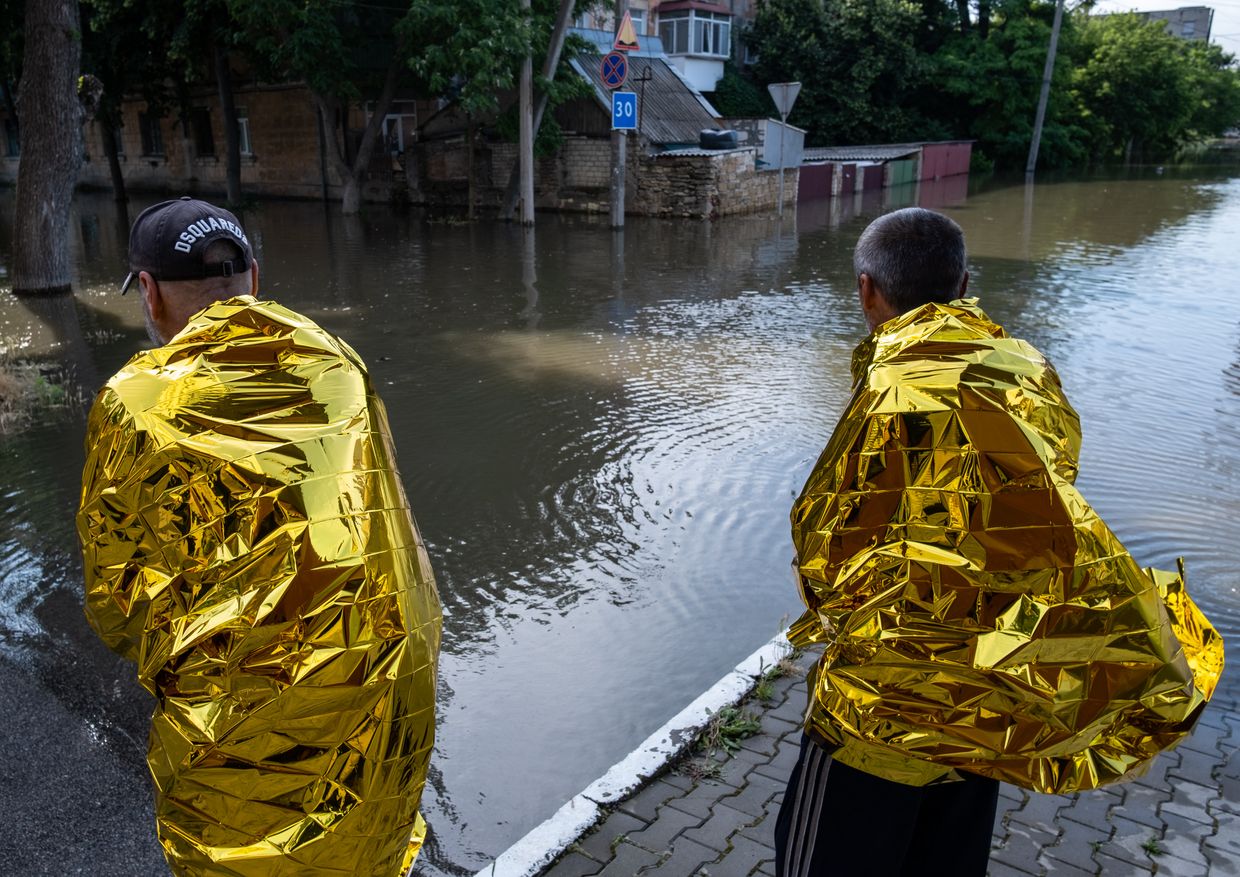 Residents of Kherson wear warming blankets after the explosion at the Kakhovka hydropower plant unleashed floodwaters in Kherson, Ukraine on June 7, 2023. (Seth Herald/Anadolu Agency via Getty Images)
Residents of Kherson wear warming blankets after the explosion at the Kakhovka hydropower plant unleashed floodwaters in Kherson, Ukraine on June 7, 2023. (Seth Herald/Anadolu Agency via Getty Images)
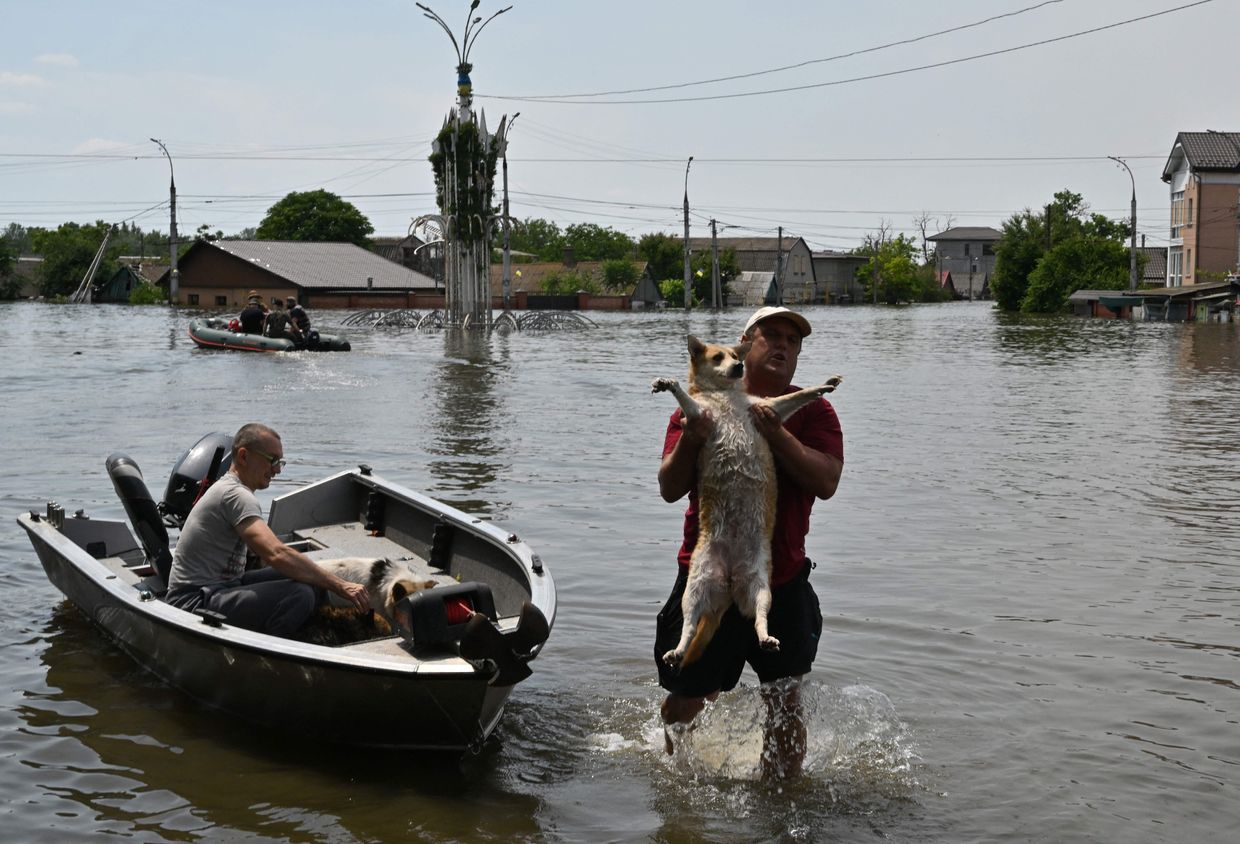 A volunteer carries a dog during an evacuation from a flooded area in Kherson, Ukraine on June 8, 2023, following damages sustained at Kakhovka hydroelectric power plant dam. (Genya Savilov / AFP via Getty Images)
A volunteer carries a dog during an evacuation from a flooded area in Kherson, Ukraine on June 8, 2023, following damages sustained at Kakhovka hydroelectric power plant dam. (Genya Savilov / AFP via Getty Images)
 Angelina Kopayeva, 12 shows picture of her family in Kherson, Ukraine on June 7, 2023. (Alex Babenko/Getty Images)
Angelina Kopayeva, 12 shows picture of her family in Kherson, Ukraine on June 7, 2023. (Alex Babenko/Getty Images)
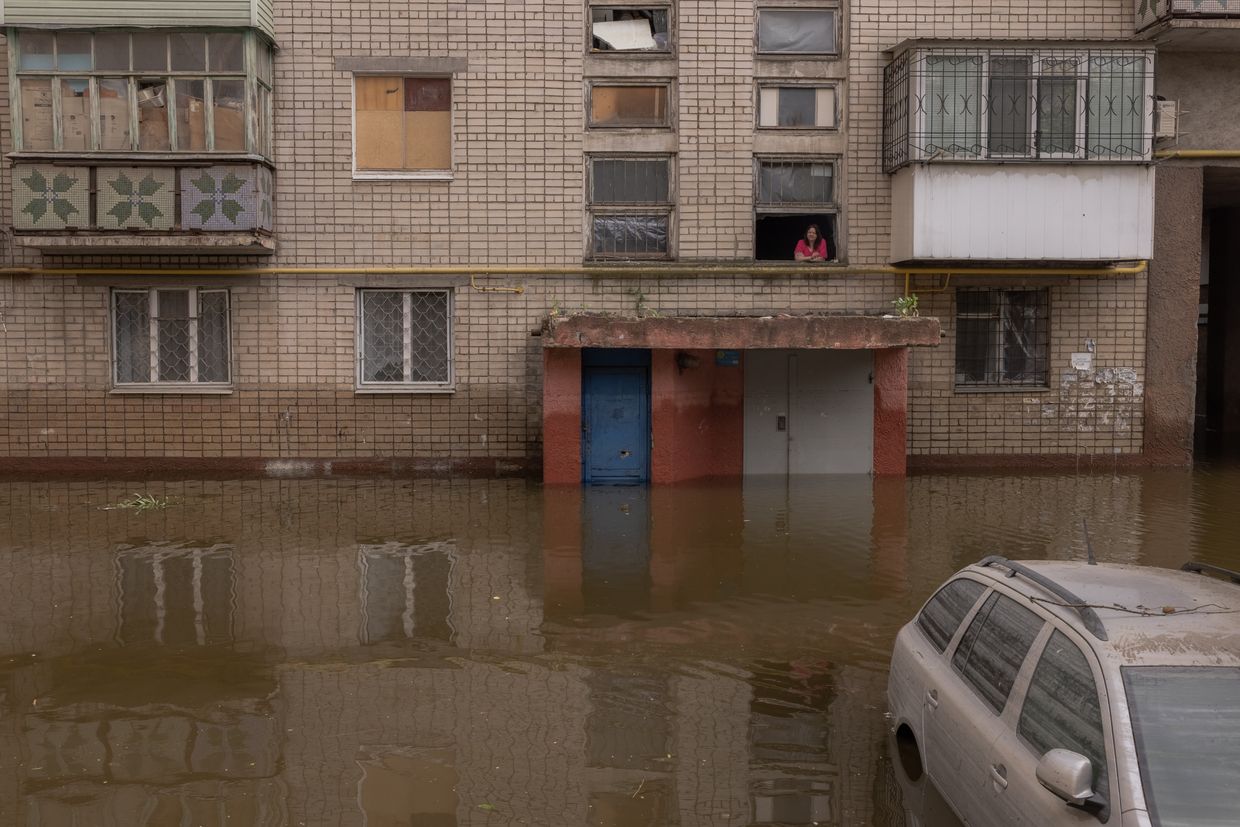 A woman stands in a flooded apartment building in Kherson, Ukraine, on June 10, 2023. (Roman Pilipey/Getty Images)
A woman stands in a flooded apartment building in Kherson, Ukraine, on June 10, 2023. (Roman Pilipey/Getty Images)

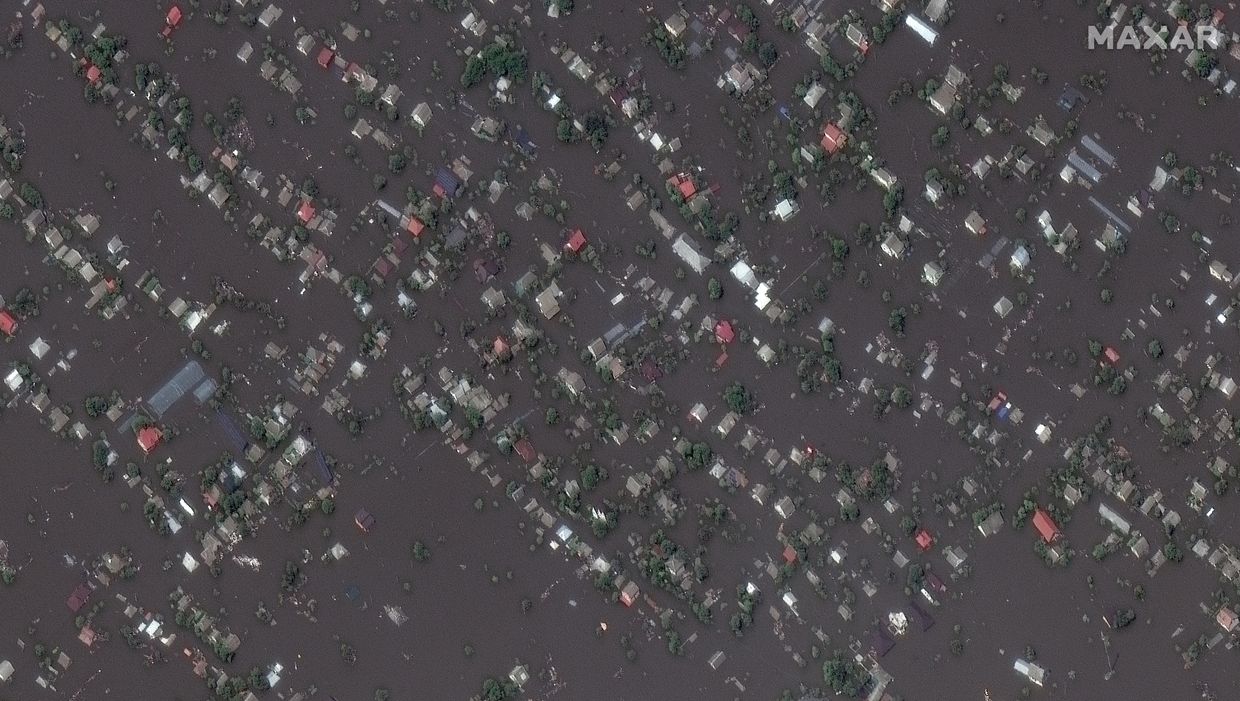 Maxar satellite imagery of the before/after images of flooded homes in Oleshky, Ukraine, on May 15, 2023, vs. June 7, 2023. (Satellite image (c) 2023 Maxar Technologies)
Maxar satellite imagery of the before/after images of flooded homes in Oleshky, Ukraine, on May 15, 2023, vs. June 7, 2023. (Satellite image (c) 2023 Maxar Technologies)
The economic toll is estimated at £3.8 billion, according to Minister of Environmental Protection and Natural Resources Ruslan Strilets.
However, calculations are still ongoing and it is not known how bad the situation is in the occupied territories. Strilets described the act as one of the worst environmental war crimes of the war. The flooding devastated ecosystems, impacted 60,000 hectares of forest, and dragged polluted water into the Black Sea poisoning wildlife.
Replacing the dam will cost £1 billion, head of Ukraine's state-owned energy company Ukrhydroenergo Ihor Syrota the day after the attack. Rebuilding work will take at least six or seven years.
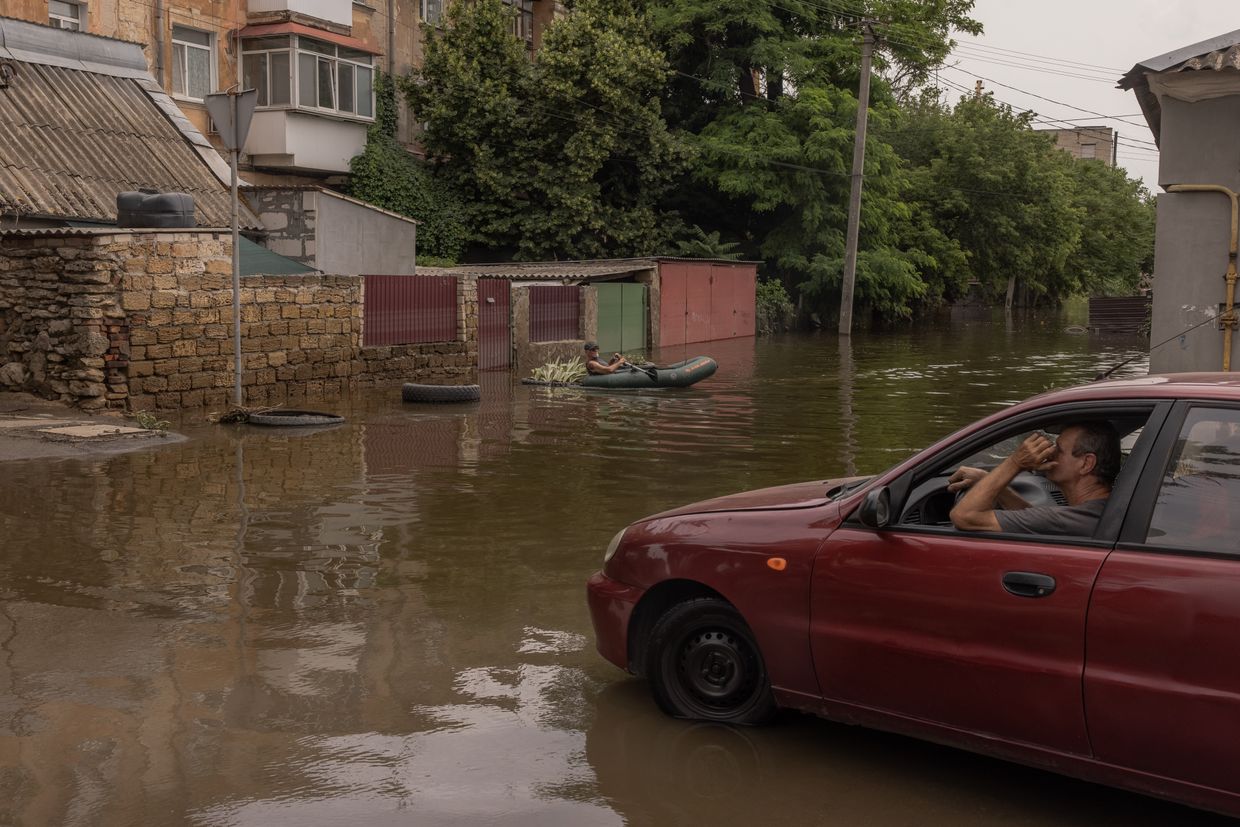 Tom, an animal rescuer from US rides an inflatable boat on a flooded street in Kherson, Ukraine on June 10, 2023. (Roman Pilipey/Getty Images)
Tom, an animal rescuer from US rides an inflatable boat on a flooded street in Kherson, Ukraine on June 10, 2023. (Roman Pilipey/Getty Images)
 People wait for a transfer on a pontoon in a flooded area as the result of the Kakhovka dam destruction on June 12, 2023 in Afanasiivka village, Mykolaiv region, Ukraine. The entrances to Afanasiivka, an island-located village with over 300 residents, were completely flooded, and now people go in and out of the village only by boats or pontoons. Last week, the Kakhovka dam and hydroelectric power plant, which sit on the Dnipro river in the southern Kherson region, were destroyed, forcing downstream communities to evacuate due to risk of flooding.
People wait for a transfer on a pontoon in a flooded area as the result of the Kakhovka dam destruction on June 12, 2023 in Afanasiivka village, Mykolaiv region, Ukraine. The entrances to Afanasiivka, an island-located village with over 300 residents, were completely flooded, and now people go in and out of the village only by boats or pontoons. Last week, the Kakhovka dam and hydroelectric power plant, which sit on the Dnipro river in the southern Kherson region, were destroyed, forcing downstream communities to evacuate due to risk of flooding.
The Dnipro river has served as a frontline between the warring armies following Russia's retreat from Kherson and surrounding areas last autumn. The impact of the dam's destruction has been felt in the wider region, imperiling agriculture and drinking water, in addition to the damage caused by floodwaters. (Roman Pilipey/Getty Images)
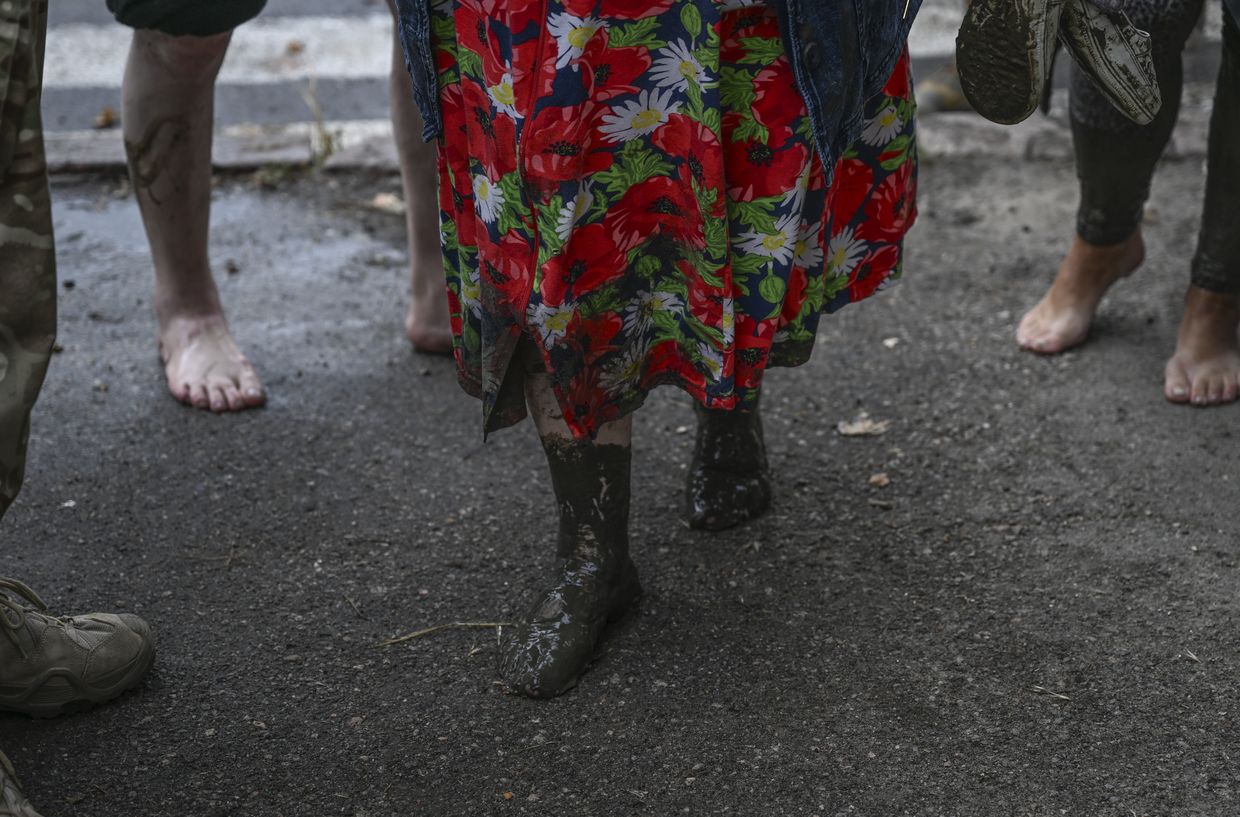 People are being evacuated from the flooded residential areas after the explosion at the Kakhovka Dam and Hydroelectric Power Plant in Kherson, Ukraine on June 14, 2023. (Ercin Erturk/Anadolu Agency via Getty Images)
People are being evacuated from the flooded residential areas after the explosion at the Kakhovka Dam and Hydroelectric Power Plant in Kherson, Ukraine on June 14, 2023. (Ercin Erturk/Anadolu Agency via Getty Images)
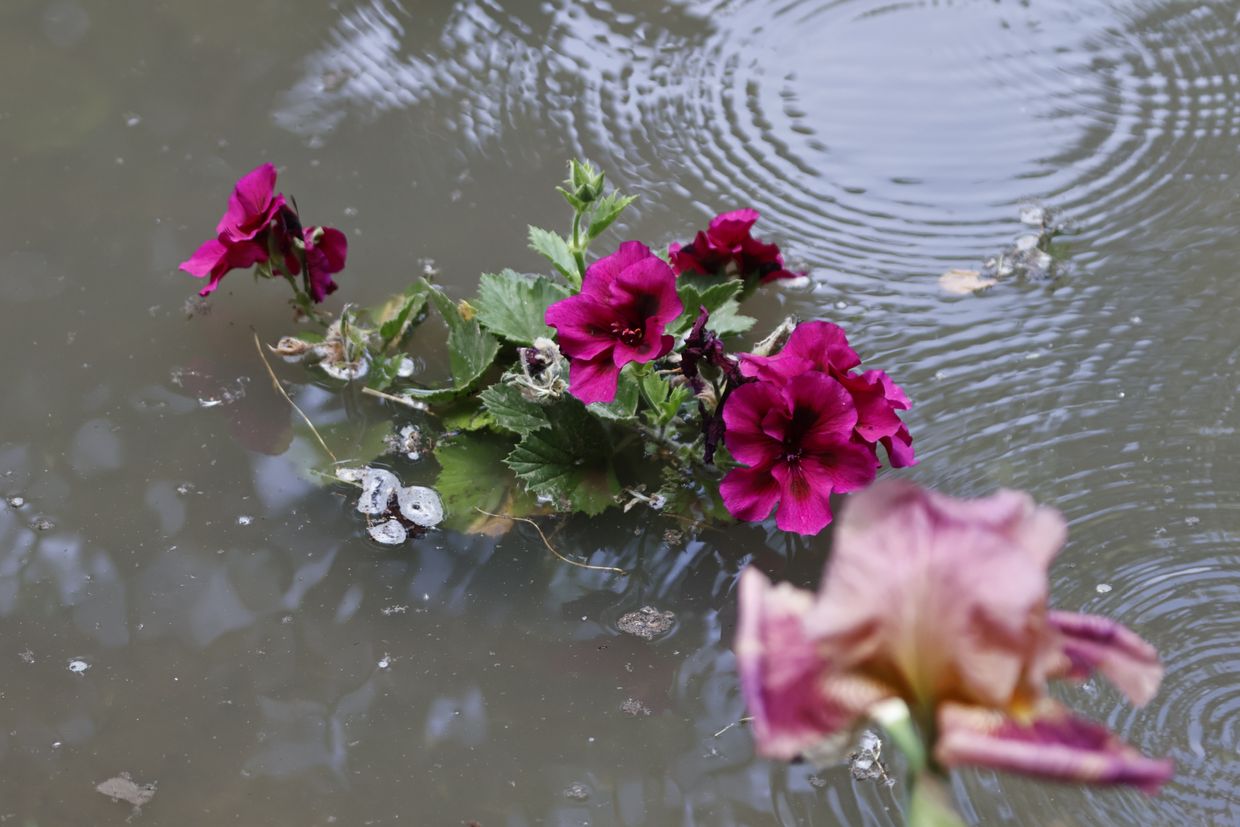 Flower in the water in the flooded area of the city in Kherson, Ukraine on June 7, 2023. (Yan Dobronosov/Global Images Ukraine via Getty Images)
Flower in the water in the flooded area of the city in Kherson, Ukraine on June 7, 2023. (Yan Dobronosov/Global Images Ukraine via Getty Images)
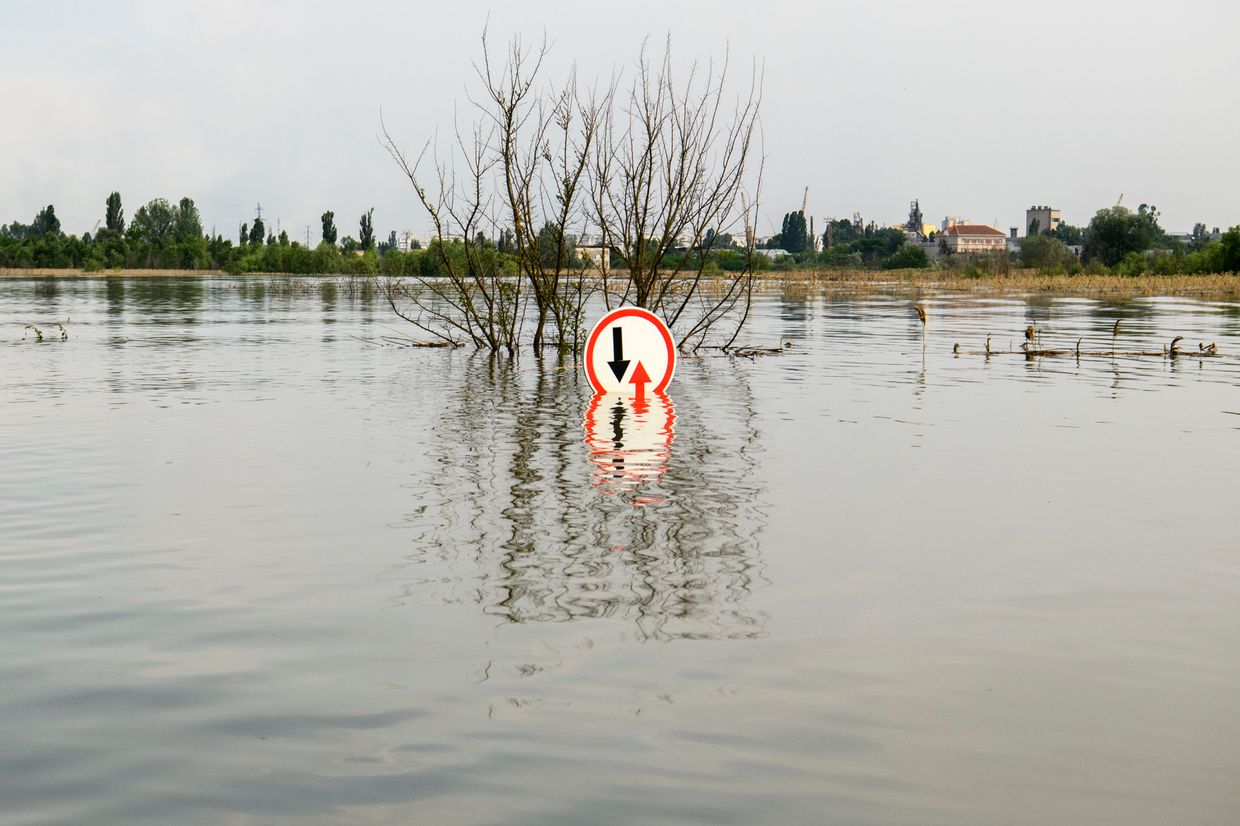 A view shows a flooded area after the Russian army destroyed the Nova Kakhovka dam in Kherson, Ukraine, on June 7, 2020. (Maxym Marusenko/NurPhoto via Getty Images).
A view shows a flooded area after the Russian army destroyed the Nova Kakhovka dam in Kherson, Ukraine, on June 7, 2020. (Maxym Marusenko/NurPhoto via Getty Images).
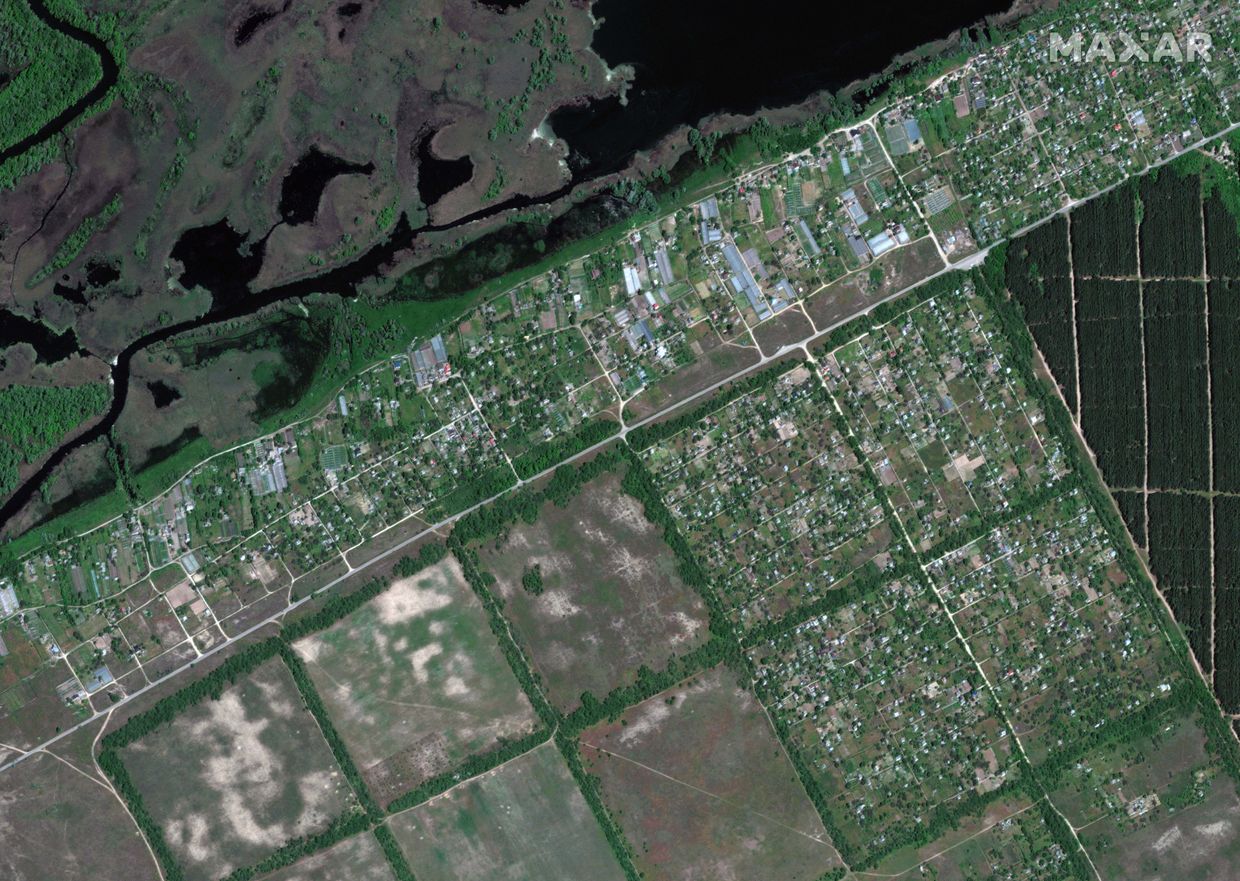
 Maxar satellite imagery of the before/after images of flooded homes in Korsunka, Ukraine on May 15, 2023 vs June 7, 2023. (Satellite image (c) 2023 Maxar Technologies)
Maxar satellite imagery of the before/after images of flooded homes in Korsunka, Ukraine on May 15, 2023 vs June 7, 2023. (Satellite image (c) 2023 Maxar Technologies)
Both Moscow and Kyiv blamed each other for the breach, but experts agree that it was likely a Russian attack. A report from the New York Times claims that explosives were strategically placed in the dam, under Russian control, with help from Soviet-era blueprints and detonated.
Kyiv long anticipated Moscow would carry out the attack. In October 2022 as Ukraine's successful counteroffensive was underway, President Volodymyr Zelensky warned that Russia was plotting to blow up the dam, saying it would lead to a "large-scale disaster."
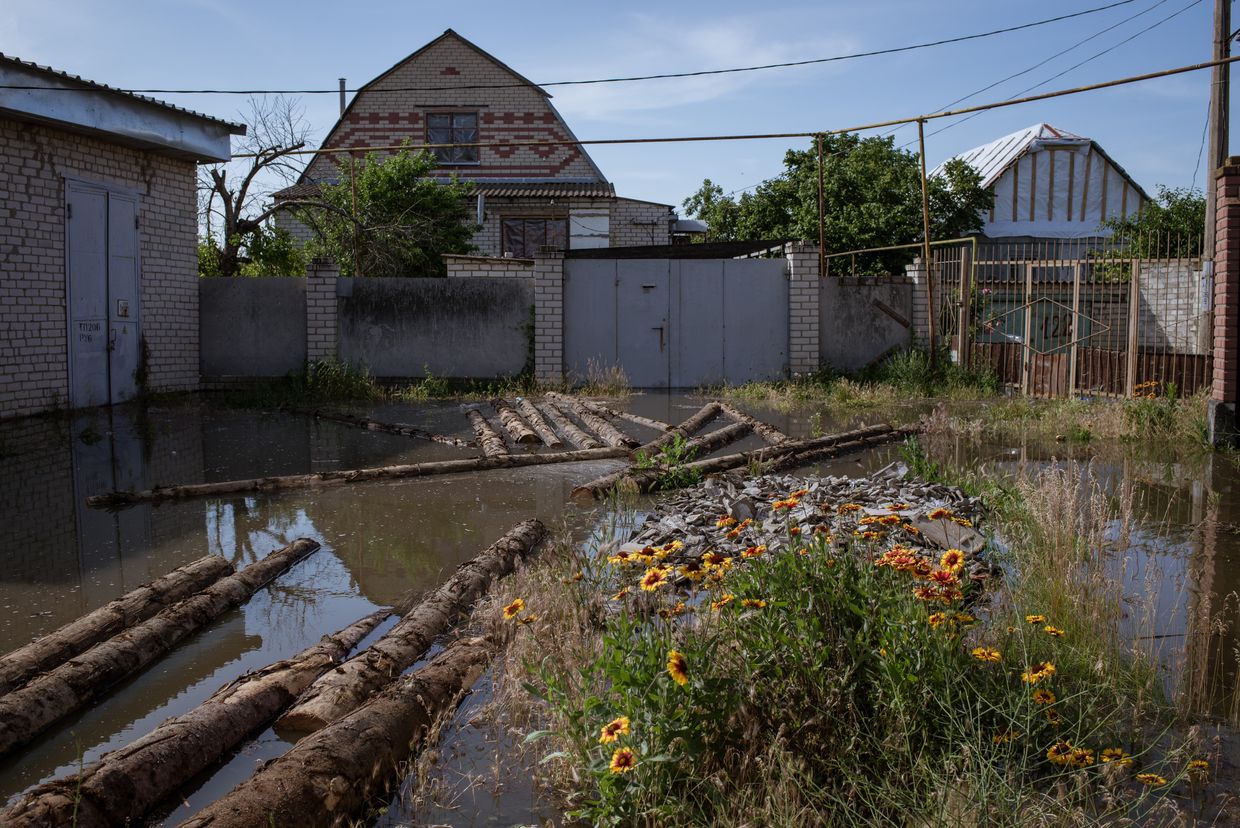 The flood after Nova Kakhovka dam explosion starts to cause damage to the houses in Kherson, Ukraine on June 7, 2023. (Andre Alves/Anadolu Agency via Getty Images)
The flood after Nova Kakhovka dam explosion starts to cause damage to the houses in Kherson, Ukraine on June 7, 2023. (Andre Alves/Anadolu Agency via Getty Images)
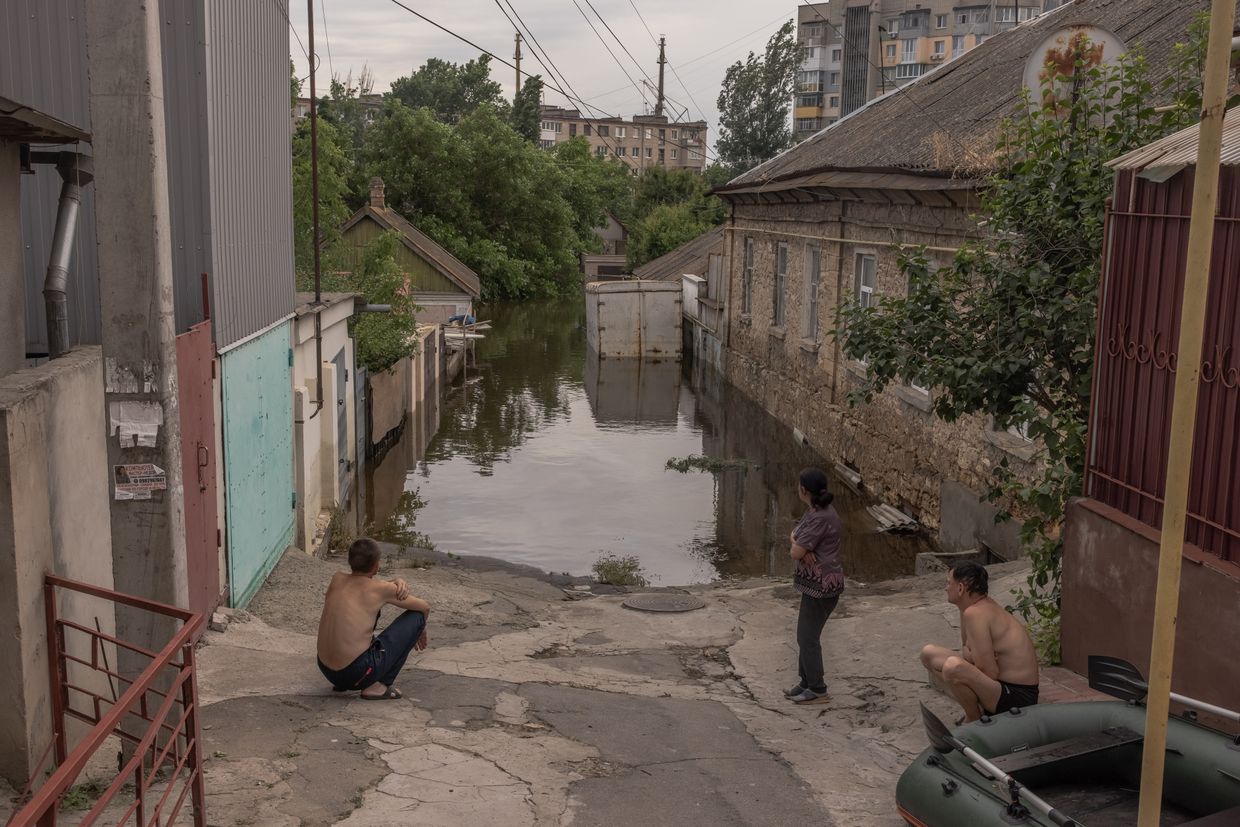 Residents sit on a flooded street in Kherson, Ukraine on June 10, 2023. (Roman Pilipey/Getty Images)
Residents sit on a flooded street in Kherson, Ukraine on June 10, 2023. (Roman Pilipey/Getty Images)
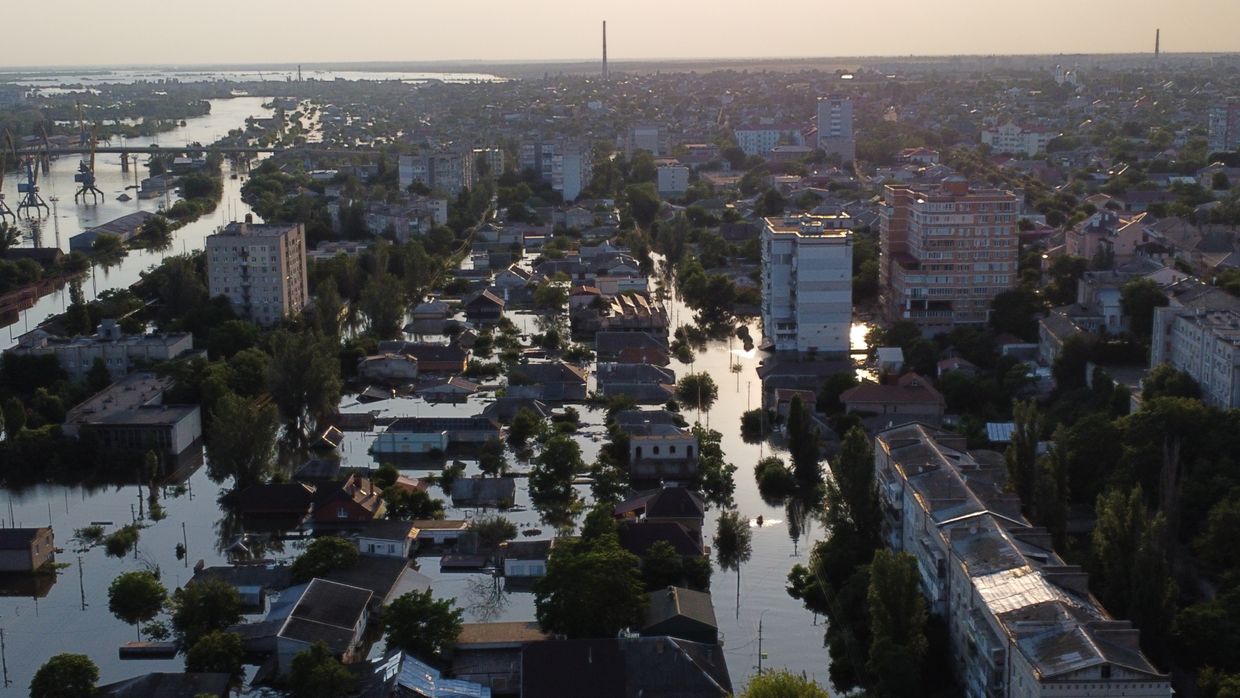 In an aerial view, residential districts in the flooded area of the city in Kherson, Ukraine on June 8, 2023. (Yan Dobronosov/Global Images Ukraine via Getty Images)
In an aerial view, residential districts in the flooded area of the city in Kherson, Ukraine on June 8, 2023. (Yan Dobronosov/Global Images Ukraine via Getty Images)
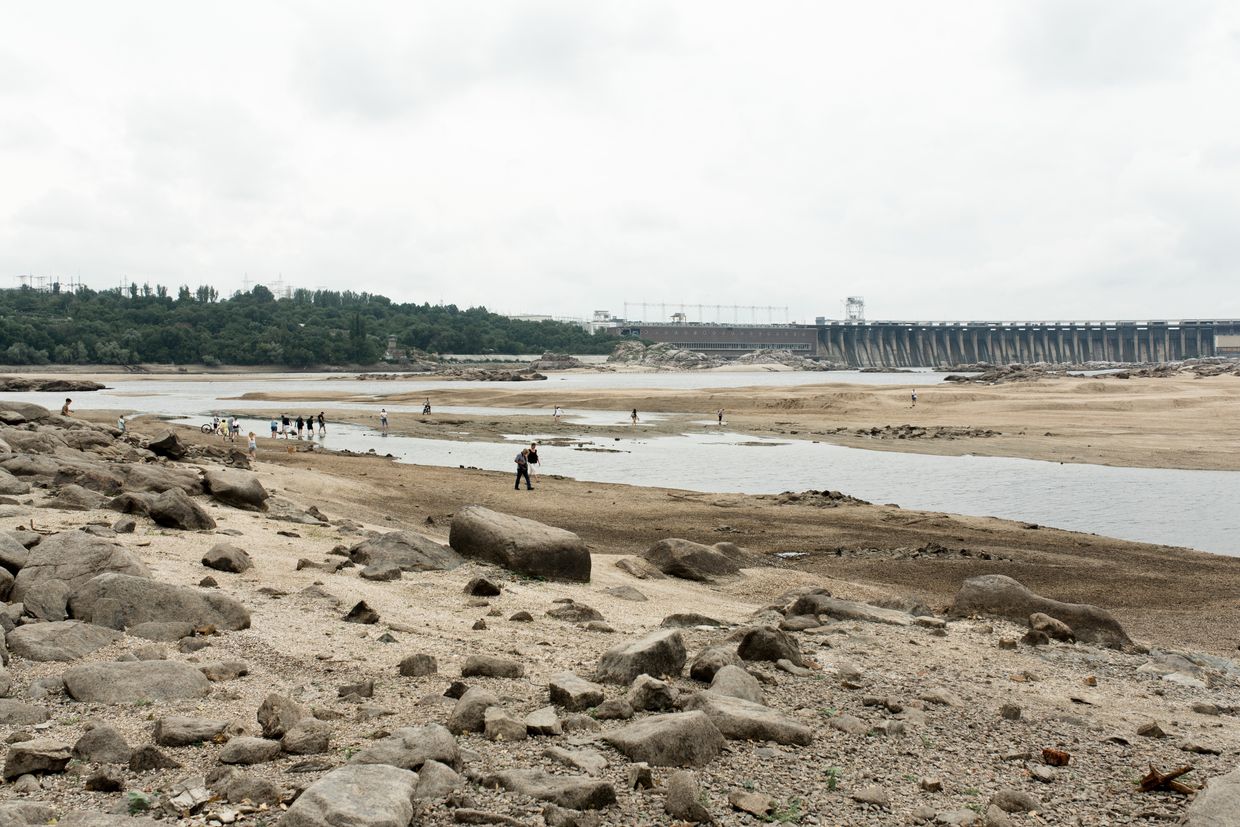 A view of the Dnipro HPP dam and the newly formed beaches of Khortytsia Island after the water level in Dnipro River fell, caused by the Kakhovka HPP Dam destruction in Zaporizhzhia, Ukraine on July 9, 2023. After the destruction of the Kakhovka Hydroelectric Power Plant Dam, the water level in the Dnipro River in Zaporizhzhia Oblast dropped significantly, leaving behind bare stones, dead fish, various debris that had been lying on the bottom for decades and forming new beaches and landscapes. (Elena Tita/Global Images Ukraine via Getty Images)
A view of the Dnipro HPP dam and the newly formed beaches of Khortytsia Island after the water level in Dnipro River fell, caused by the Kakhovka HPP Dam destruction in Zaporizhzhia, Ukraine on July 9, 2023. After the destruction of the Kakhovka Hydroelectric Power Plant Dam, the water level in the Dnipro River in Zaporizhzhia Oblast dropped significantly, leaving behind bare stones, dead fish, various debris that had been lying on the bottom for decades and forming new beaches and landscapes. (Elena Tita/Global Images Ukraine via Getty Images)
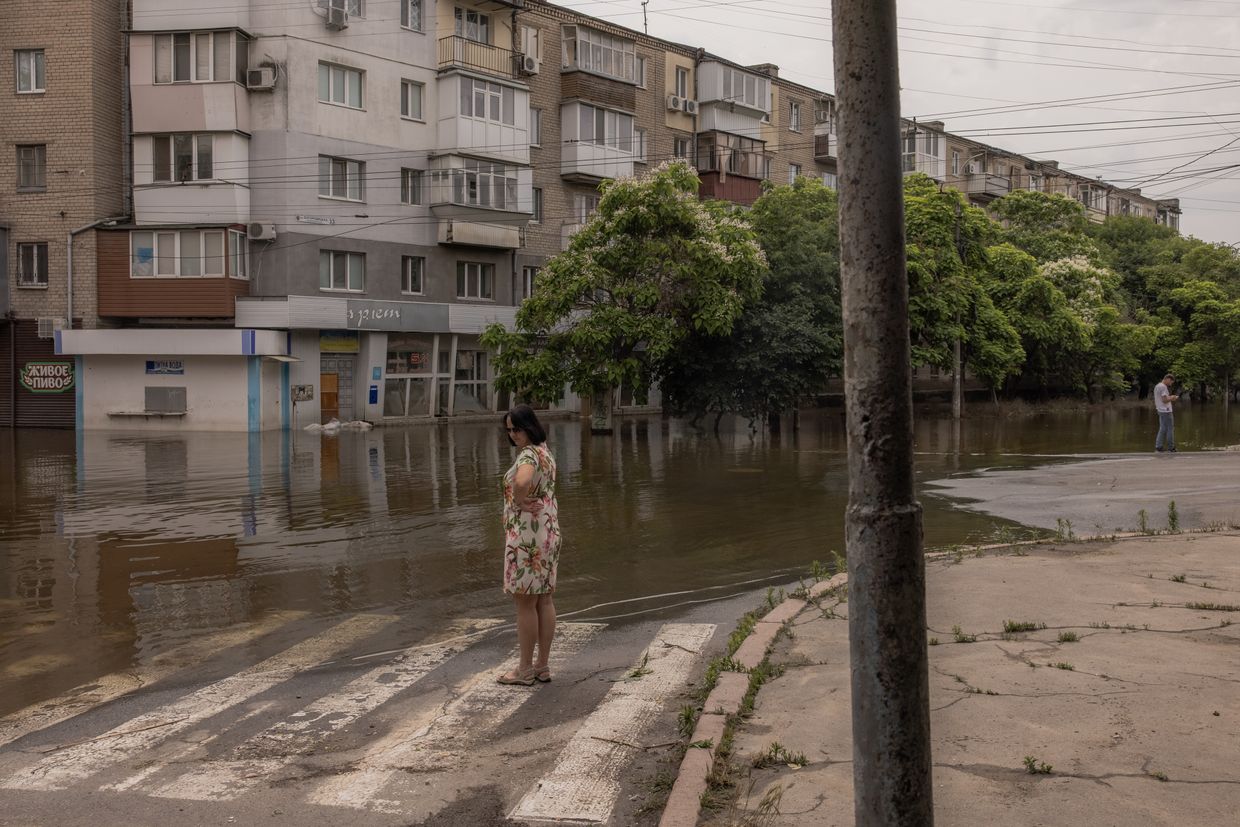 A woman stands on a flooded street in Kherson, Ukraine on June 10, 2023. (Roman Pilipey/Getty Images)
A woman stands on a flooded street in Kherson, Ukraine on June 10, 2023. (Roman Pilipey/Getty Images)
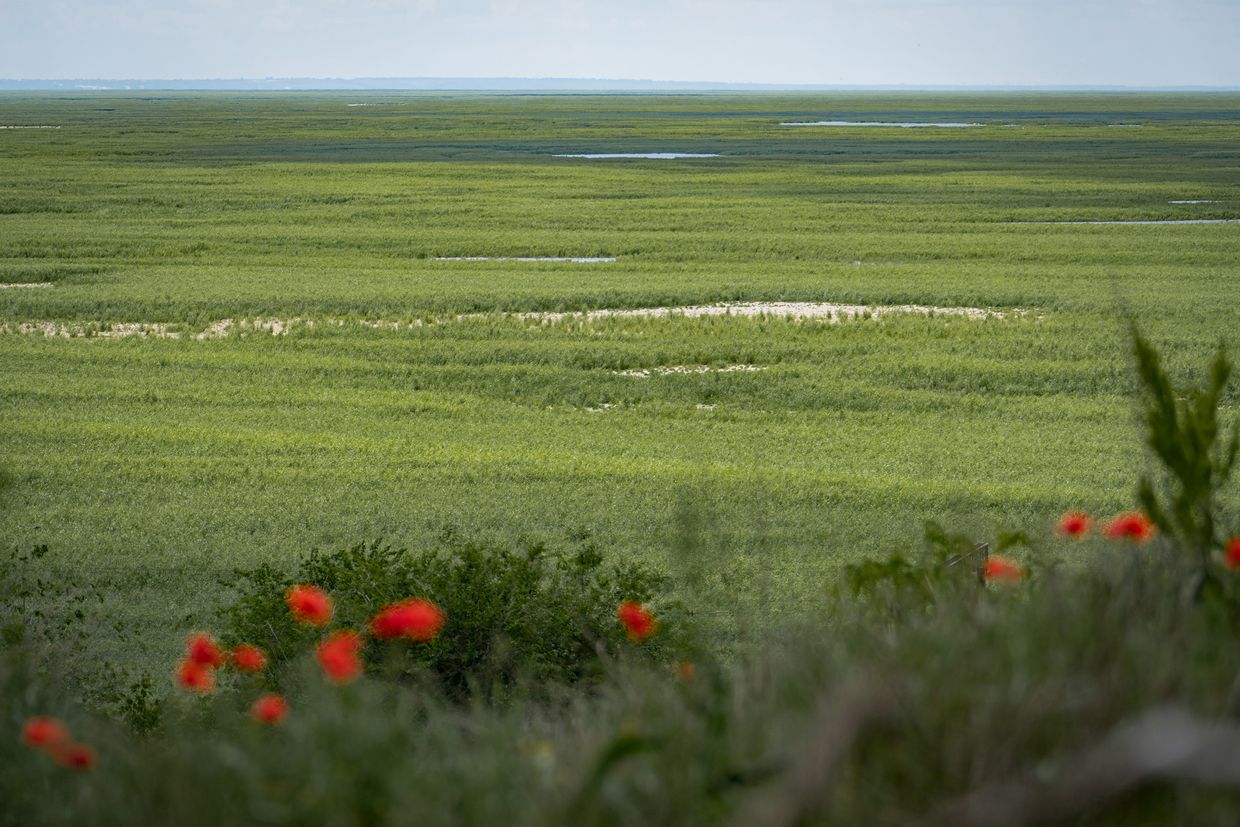 A general view of dried-up lands of Kakhovka Reservoir, overgrown with thick vegetation in Zaporizhzhia Oblast, Ukraine on May 16, 2024.
A general view of dried-up lands of Kakhovka Reservoir, overgrown with thick vegetation in Zaporizhzhia Oblast, Ukraine on May 16, 2024.
After the Kakhovka Dam was blown up on June 6, 2023, water from the Kakhovka Reservoir flowed downstream, destroying towns, villages, and all life in its path. On the site of the former Reservoir, on 150,000 hectares of dried-up lands, a thick forest has grown in almost a year. The vegetation here is diverse: a larger area is occupied by willow trees 2.5-3 meters high, rumex aquaticus and celtis occidentalis.
Over time, according to ecologist Vadym Manyuk, the number of trees and plants will decrease, and new types of plants will be sown such as elm and pedunculate oak. (Yurii Tynnyi/Suspilne Ukraine/JSC "UA:PBC"/Global Images Ukraine via Getty Images)